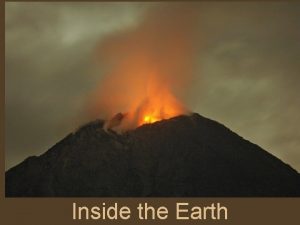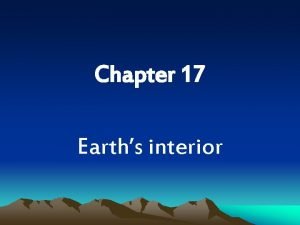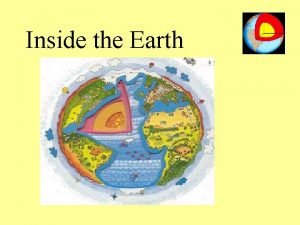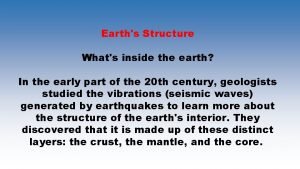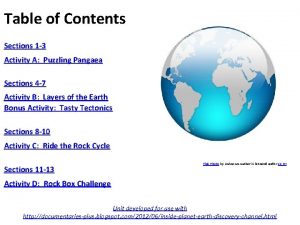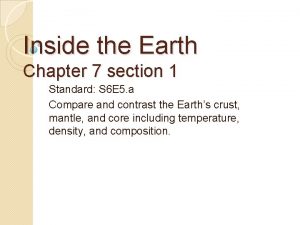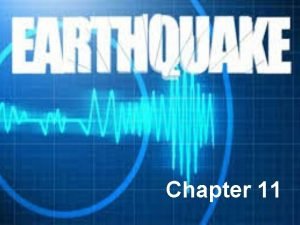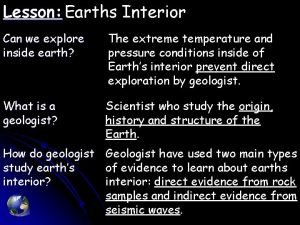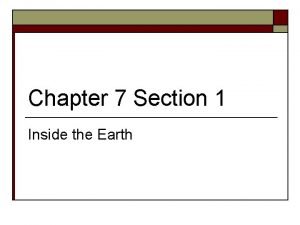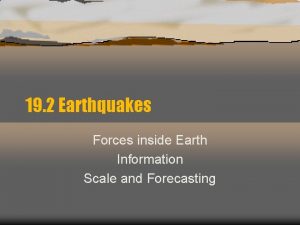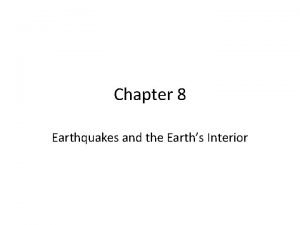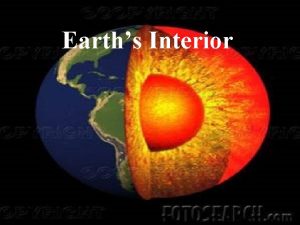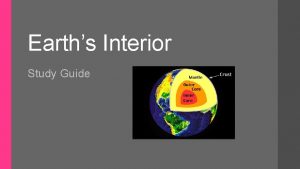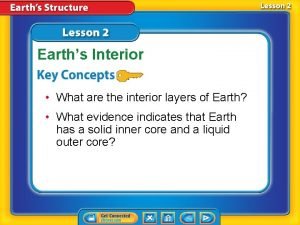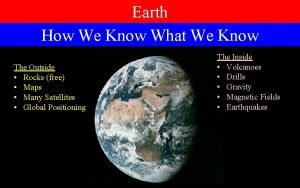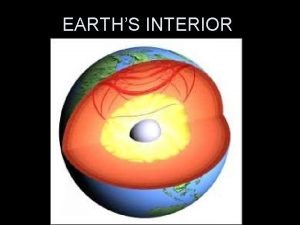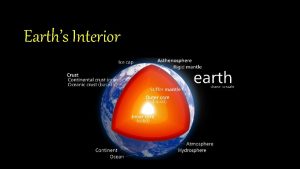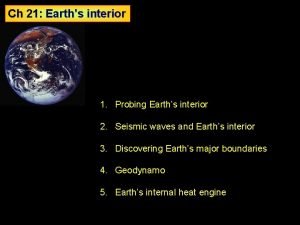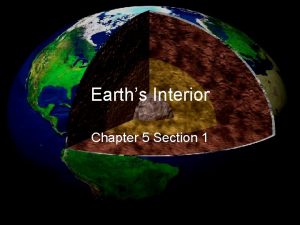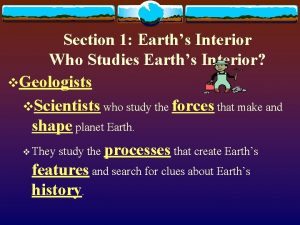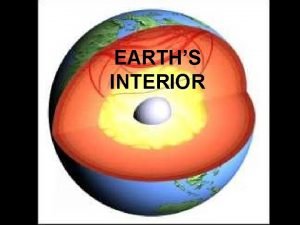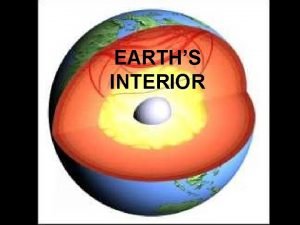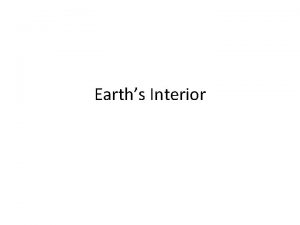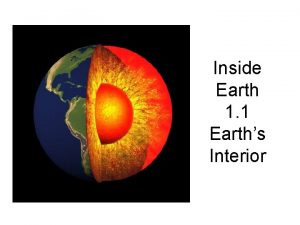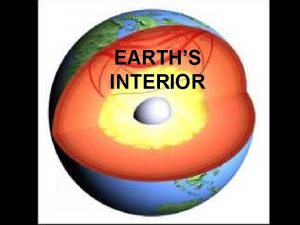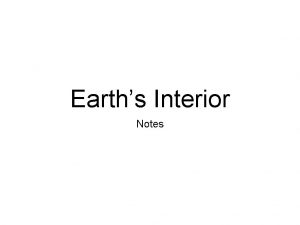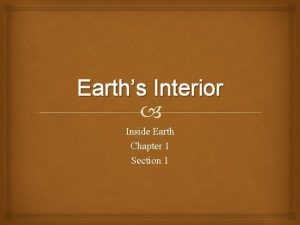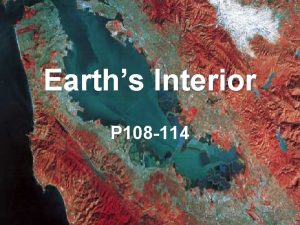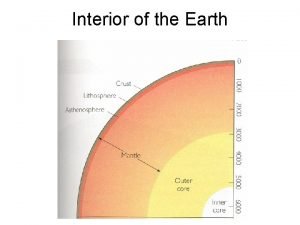Inside the Earth Earths Interior Earths interior is


















- Slides: 18

Inside the Earth

Earth’s Interior • Earth’s interior is divided into layers: the crust, mantle, & core, based on composition. Although the Earth’s crust seem stable, the extreme heat of the Earth’s interior causes changes that slowly reshape the surface.


The Crust • Outermost layer of earth made of rock that forms earth’s outer skin • 5 to 100 km thick, average thickness is 35 km • thinnest layer • less than 1% of Earth’s mass • Composition of crust: oxygen, silicon, aluminum, calcium, iron, sodium, potassium, magnesium

The Crust • Oceanic Crust – crust beneath the oceans – consist mainly of dense rock (basalt - dark in color) – 5 -8 km thick • Continental Crust – crust that forms the continents – consist mainly of less dense rock (granite lighter in color) – 30 km average thickness

Crust to Mantle • The upper part of the mantle and the crust together form a rigid layer called the lithosphere. » Lithos is greek for stone, 100 km thick » made of pieces called tectonic plates

Tectonic Plates • The tectonic plates are pieces of the lithosphere that fit like pieces of a jigsaw puzzle and move on top of the asthenosphere • May Consist of both Continental and Oceanic Crust

Major tectonic plates: Pacific plate North American plate Cocos plate Nazca plate Antarctic Plate South American Plate Eurasian Plate Indian Plate Australian Plate

Crust to Mantle • The asthenosphere is a soft layer of the mantle on which pieces of the lithosphere move – asthenes is Greek for soft or weak – material is like warm tar and can flow slowly • The rigid crust and lithosphere float on the hot, plastic material of the asthenosphere.

The Mantle • layer of rock between crust and core • 2900 km thick, 67% of Earth’s mass • Composition - silicon, oxygen, iron and magnesium • physical conditions in mantle change because pressure and temperature increase with depth – temp ranges from 870 ºC to 2, 200ºC

Convection Currents inside the Mantle • Hot columns of mantle material rise slowly through the asthenosphere


The Core • Innermost layer of the Earth • 6800 km in diameter (3, 400 km from outside edge of core to center of core) • 1/3 of Earth’s mass, 15% of its volume • Temperature ranges from 2, 000 ºC to 5, 000ºC – Consist of 2 parts; Inner Core and Outer Core

The Outer Core • layer of molten metal (iron and nickel) beneath the mantle • surrounds the inner core • 2, 200 km thick

The Inner Core • dense ball of solid metal (iron and nickel) • extreme pressure from layers above • 1200 km, from outside edge of inner core to center

Earth’s Magnetic Field • Currents in the liquid outer core force the solid inner core to spin • The inner core spins inside the Earth at a slightly faster rate than the rest of the planet • This movement creates the Earth’s magnetic field

Earth’s Magnetic Field • The earth acts as a giant bar magnet • Earth’s magnetic fields have reversed more than 177 times in the last 85 million years

The End
 Earths interior
Earths interior Inside the earth layers
Inside the earth layers Produced from the heat inside the earth
Produced from the heat inside the earth What is inside of earth
What is inside of earth Whats inside the earth
Whats inside the earth Tasty tectonics answer key
Tasty tectonics answer key Composition of the earth's crust
Composition of the earth's crust Chapter 7 section 1 inside the earth answer key
Chapter 7 section 1 inside the earth answer key Forces inside earth
Forces inside earth Why is the inside of the earth hot
Why is the inside of the earth hot Chapter 7 section 1 inside the earth answer key
Chapter 7 section 1 inside the earth answer key Forces
Forces Chapter 8 earthquakes and earth's interior
Chapter 8 earthquakes and earth's interior Earth's interior
Earth's interior How do geologists study direct evidence of earth's interior
How do geologists study direct evidence of earth's interior How did deep mines and wells give clues to earth's interior
How did deep mines and wells give clues to earth's interior Earth's interior
Earth's interior To study earth's interior geologists often rely on
To study earth's interior geologists often rely on Core mantle crust
Core mantle crust

